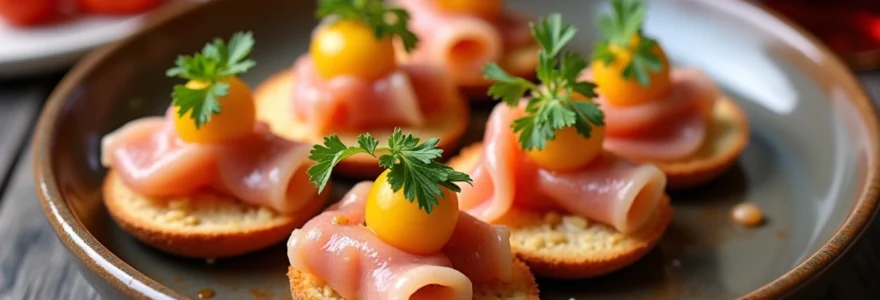Tapas, the quintessential Spanish culinary tradition, embodies the vibrant and social essence of Spanish cuisine. These small, flavorful dishes have evolved from humble beginnings to become a cornerstone of Spain’s gastronomic identity. Tapas represent more than just food; they’re a way of life, encouraging conviviality and the sharing of both meals and moments. From bustling bars in Madrid to seaside chiringuitos in Barcelona, tapas offer a tantalizing glimpse into the diverse regional flavors and culinary techniques that make Spanish cuisine so captivating.
The world of tapas is as varied as Spain itself, with each region boasting its own specialties and preparation methods. Whether you’re savoring pintxos in San Sebastián or indulging in pescaíto frito in Seville, tapas provide a delicious journey through Spain’s culinary landscape. This small-plate dining style not only showcases the country’s rich ingredients and cooking traditions but also reflects the Spanish approach to dining—unhurried, social, and deeply pleasurable.
Origins and evolution of spanish tapas: from castile to nationwide tradition
The origin of tapas is steeped in legend and folklore, with several stories vying for recognition as the true birth of this culinary custom. One popular tale attributes the creation of tapas to King Alfonso X of Castile in the 13th century. According to this narrative, the monarch, while recovering from an illness, could only consume small portions of food with wine. Upon regaining his health, he decreed that taverns should always serve a small snack or “tapa” (cover) with drinks, to prevent quick intoxication.
Another origin story suggests that tapas began as a practical solution for farmers and laborers who needed small, energizing bites to sustain them between meals. These workers would often cover their glasses of wine with a slice of bread or meat to keep out dust and insects, inadvertently creating the first “tapa.”
Regardless of its true origins, the concept of tapas spread throughout Spain, evolving from simple covers for drinks to an elaborate culinary art form. By the 19th century, tapas had become an integral part of Spanish dining culture, with each region developing its own unique variations based on local ingredients and traditions.
The 20th century saw tapas transform from a primarily rural tradition to a sophisticated urban dining experience. As Spain’s cities grew and modernized, tapas bars became social hubs where people from all walks of life could gather to enjoy good food, drink, and company. This democratization of tapas culture helped cement its place in Spanish society and contributed to its worldwide popularity.
Regional tapas specialties across spain
Spain’s diverse geography and cultural heritage have given rise to a rich tapestry of regional tapas specialties. From the verdant hills of the Basque Country to the sun-drenched coasts of Andalusia, each area of Spain offers its own unique take on the tapas tradition. These regional variations not only showcase local ingredients and cooking methods but also reflect the history and character of their respective regions.
Pintxos of the basque country: gilda and txangurro
In the Basque Country, tapas take on a distinctive form known as pintxos . These are typically small, elaborate creations served on a slice of bread and held together with a toothpick. The most iconic pintxo is the Gilda, named after Rita Hayworth’s character in the film of the same name. It consists of an olive, an anchovy, and a pickled guindilla pepper—a perfect balance of salt, brine, and heat.
Another Basque favorite is Txangurro, a dish of stuffed spider crab. The crab meat is mixed with onions, tomatoes, and brandy, then baked in its shell and often served as a warm pintxo. This luxurious bite exemplifies the Basque Country’s rich seafood tradition and culinary sophistication.
Andalusian tapas: gazpacho shots and pescaíto frito
Andalusia, with its scorching summers and Moorish influences, has developed tapas that are both refreshing and flavorful. Gazpacho, the cold tomato soup, is often served in shot glasses as a tapa, offering a cooling respite from the heat. This simple yet elegant dish showcases the region’s abundant tomatoes and the Spanish knack for transforming humble ingredients into culinary delights.
Pescaíto frito , or fried fish, is another Andalusian staple. Small fish such as anchovies or sardines are lightly battered and quickly fried, resulting in a crispy exterior and tender, flavorful flesh. This tapa reflects Andalusia’s long coastline and the importance of seafood in its cuisine.
Catalan tapas: pan con tomate and bombas
Catalonia’s tapas culture blends Mediterranean influences with a penchant for rustic simplicity. Pan con tomate , or bread with tomato, is a prime example of this philosophy. Fresh bread is rubbed with ripe tomatoes and drizzled with olive oil, creating a tapa that’s greater than the sum of its parts. This dish’s popularity has spread throughout Spain, becoming a staple in tapas bars nationwide.
Bombas, a creation from Barcelona’s La Barceloneta neighborhood, are another Catalan favorite. These potato croquettes are filled with minced meat, breaded, and fried until golden. Served with a spicy sauce and aioli, bombas offer a delicious contrast of textures and flavors in a single bite.
Galician tapas: pulpo a la gallega and pimientos de padrón
Galicia, in Spain’s verdant northwest, is renowned for its seafood and agricultural bounty. Pulpo a la gallega , or Galician-style octopus, is a quintessential tapa from this region. Tender octopus is boiled, sliced, and served on wooden plates with a drizzle of olive oil, a sprinkle of paprika, and a dash of sea salt. The simplicity of this dish allows the quality of the octopus to shine through.
Pimientos de Padrón are small green peppers that are a beloved tapa throughout Spain, but they originate from the Galician town of Padrón. These peppers are simply fried in olive oil and sprinkled with coarse salt, creating a dish that’s both straightforward and addictive. Part of their allure lies in their unpredictability—while most are mild, occasionally you’ll encounter a fiery one, adding an element of surprise to each serving.
Essential ingredients in spanish tapas cuisine
The rich tapestry of Spanish tapas is woven from a selection of high-quality ingredients that form the backbone of this culinary tradition. These components, ranging from cured meats to artisanal cheeses and fresh seafood, not only provide the distinctive flavors associated with Spanish cuisine but also reflect the country’s diverse geography and agricultural heritage.
Jamón ibérico: grades, curing process, and serving techniques
Jamón ibérico , or Iberian ham, is perhaps the most revered ingredient in Spanish gastronomy. This dry-cured ham comes from black Iberian pigs, with the finest varieties produced from animals fed exclusively on acorns. The curing process can take up to four years, resulting in a product of unparalleled flavor and texture.
There are four grades of jamón ibérico, distinguished by the diet and lifestyle of the pigs:
- Jamón Ibérico de Bellota (100% Ibérico): From pure-bred Iberian pigs fed exclusively on acorns
- Jamón Ibérico de Bellota: From Iberian cross-bred pigs fed on acorns and grains
- Jamón Ibérico de Cebo de Campo: From pigs fed on a mixture of acorns and grain in open pasture
- Jamón Ibérico de Cebo: From pigs fed on commercial grain feed
Serving jamón ibérico is an art form in itself. The ham is typically sliced paper-thin, allowing it to melt on the tongue and release its complex flavors. It’s often served on its own as a tapa, allowing diners to appreciate its nuanced taste fully.
Olive oil varieties: arbequina, picual, and hojiblanca
Olive oil is the lifeblood of Spanish cuisine, used in everything from cooking to finishing dishes. Spain is the world’s largest producer of olive oil, with a variety of cultivars each offering distinct flavor profiles. Three of the most prominent varieties are:
- Arbequina: Produces a delicate, fruity oil with hints of apple and almond
- Picual: Yields a robust, peppery oil with a slightly bitter finish
- Hojiblanca: Creates a well-balanced oil with notes of green apple and fresh grass
These oils are not just cooking ingredients but often featured prominently in tapas. A simple yet delicious tapa might consist of high-quality bread drizzled with extra virgin olive oil, showcasing the oil’s flavor and aroma.
Spanish cheeses: manchego, cabrales, and tetilla
Spain boasts a rich tradition of cheese-making, with each region producing its own unique varieties. These cheeses often feature prominently in tapas, either as standalone dishes or as components of more complex creations. Some notable Spanish cheeses include:
- Manchego: A firm sheep’s milk cheese from La Mancha, known for its nutty flavor and distinctive herringbone rind
- Cabrales: A strong blue cheese from Asturias, often crumbled over tapas or served with crusty bread
- Tetilla: A soft cow’s milk cheese from Galicia with a mild, creamy flavor and distinctive cone shape
These cheeses not only provide a delicious accompaniment to wine but also serve as a canvas for creative tapas combinations. For example, Manchego might be paired with quince paste for a classic sweet and savory tapa, while Cabrales could be melted over grilled mushrooms for a rich, umami-packed bite.
Seafood in tapas: bacalao, gambas, and boquerones
Given Spain’s extensive coastline, it’s no surprise that seafood plays a crucial role in tapas cuisine. From the Atlantic to the Mediterranean, Spanish waters provide a bounty of fish and shellfish that feature prominently in tapas bars across the country. Some essential seafood ingredients in Spanish tapas include:
- Bacalao: Salt cod, often rehydrated and used in dishes like croquetas or served with tomato sauce
- Gambas: Shrimp, frequently prepared al ajillo (with garlic) or a la plancha (grilled)
- Boquerones: Fresh anchovies marinated in vinegar, a popular tapa especially in coastal regions
These seafood tapas showcase Spain’s mastery of simple yet flavorful preparations. A plate of perfectly grilled gambas sprinkled with sea salt or a serving of delicate boquerones drizzled with good olive oil exemplifies the Spanish approach to tapas—letting high-quality ingredients speak for themselves.
Tapas etiquette and social customs in spain
Understanding tapas etiquette is crucial for fully immersing yourself in Spanish dining culture. Unlike formal meals, tapas are meant to be a casual, social experience. Here are some key points to remember:
Sharing is caring: Tapas are designed to be shared among friends. It’s common to order several dishes for the table rather than individual plates. This encourages conversation and allows everyone to try a variety of flavors.
Standing room only: Many traditional tapas bars don’t have seating. Patrons often stand at the bar or at tall tables, facilitating movement and social interaction. Don’t be surprised if you find yourself rubbing elbows with locals as you enjoy your tapas.
Timing is everything: In Spain, lunch is typically eaten between 2 pm and 4 pm, while dinner starts late, often after 9 pm. Tapas can be enjoyed at any time but are particularly popular in the early evening as a light meal before a late dinner.
Pay as you go: In many tapas bars, especially in more traditional establishments, it’s common to pay for each round of drinks and tapas as they’re served. This system, known as el escote , allows for flexibility in how long you stay and how much you consume.
Mind your manners: While tapas culture is casual, certain etiquette rules apply. Use toothpicks or utensils provided to take your portion from shared plates, and avoid double-dipping. It’s also polite to offer the last piece of a shared tapa to others before taking it yourself.
Pairing tapas with spanish wines and beverages
The art of pairing tapas with the right drink is an integral part of the Spanish dining experience. While wine is a popular choice, other beverages like sherry, beer, and vermouth also play important roles in tapas culture. Understanding these pairings can enhance your tapas experience and provide insight into regional drinking traditions.
Sherry varieties: fino, manzanilla, and oloroso
Sherry, or Jerez in Spanish, is a fortified wine from Andalusia that pairs exceptionally well with many tapas. Different styles of sherry complement various types of tapas:
- Fino: A dry, light-bodied sherry that pairs well with seafood tapas and salty snacks
- Manzanilla: Similar to Fino but with a slightly salty note, perfect with olives and almonds
- Oloroso: A darker, nuttier sherry that complements rich meat tapas and aged cheeses
The versatility of sherry makes it an excellent choice for accompanying a variety of tapas. Its complex flavors can stand up to bold dishes while also enhancing more delicate preparations.
Spanish red wines: rioja, ribera del duero, and priorat
Spain’s red wines are renowned worldwide, and they pair beautifully with many tapas dishes. Some notable regions and their characteristic wines include:
- Rioja: Known for elegant, oak-aged reds that pair well with jamón and grilled meats
- Ribera del Duero: Produces full-bodied reds that complement rich tapas like chorizo or morcilla
- Priorat: Creates powerful, mineral-driven reds that stand up to hearty meat dishes
When pairing red wines with tapas, consider the intensity of both the wine and the dish. A light Rioja might pair well with a simple cheese tapa, while a robust Priorat could complement a more intensely flavored meat dish.
Cava and its role in tapas culture
Cava, Spain’s sparkling wine, is produced primarily in Catalonia and is an excellent choice for many tapas. Its effervescence and acidity make it a versatile pairing option, cutting through rich flavors and cleansing the palate between bites.
Cava works particularly well with fried tapas, seafood dishes, and cured meats. Its celebratory nature also makes it a popular choice for starting or ending a tapas crawl. From brut nature (very dry) to semi-seco (slightly sweet), different styles of cava can complement a wide range of tapas flavors.
Modern innovations and fusion tapas in contemporary spanish cuisine
While traditional tapas remain beloved, contemporary Spanish chefs are pushing the boundaries of what constitutes a tapa. This culinary innovation has led to the creation of fusion tapas
that blend traditional Spanish ingredients with international flavors and techniques. This evolution reflects Spain’s openness to global culinary influences while maintaining its strong gastronomic identity.
Some examples of modern fusion tapas include:
- Sushi-style rolls filled with Spanish ingredients like jamón and manchego
- Croquetas infused with Indian spices or Japanese matcha
- Miniature versions of international dishes adapted to use Spanish products
Renowned chefs like Ferran Adrià and the Roca brothers have played a significant role in elevating tapas to new heights, incorporating molecular gastronomy techniques and avant-garde presentations. Their innovations have inspired a new generation of Spanish chefs to experiment with textures, temperatures, and unexpected flavor combinations.
Modern tapas bars are also embracing sustainable and locally-sourced ingredients, often featuring vegetarian and vegan options to cater to changing dietary preferences. This shift not only broadens the appeal of tapas but also aligns with growing environmental concerns.
Despite these innovations, the essence of tapas culture remains unchanged. Whether traditional or modern, tapas continue to embody the Spanish spirit of conviviality, encouraging shared experiences and lively conversation over good food and drink.
As tapas culture evolves, it continues to captivate food lovers worldwide, serving as a delicious ambassador for Spanish cuisine and lifestyle. The blend of time-honored traditions with contemporary creativity ensures that tapas will remain a vibrant and dynamic part of Spain’s culinary landscape for generations to come.


